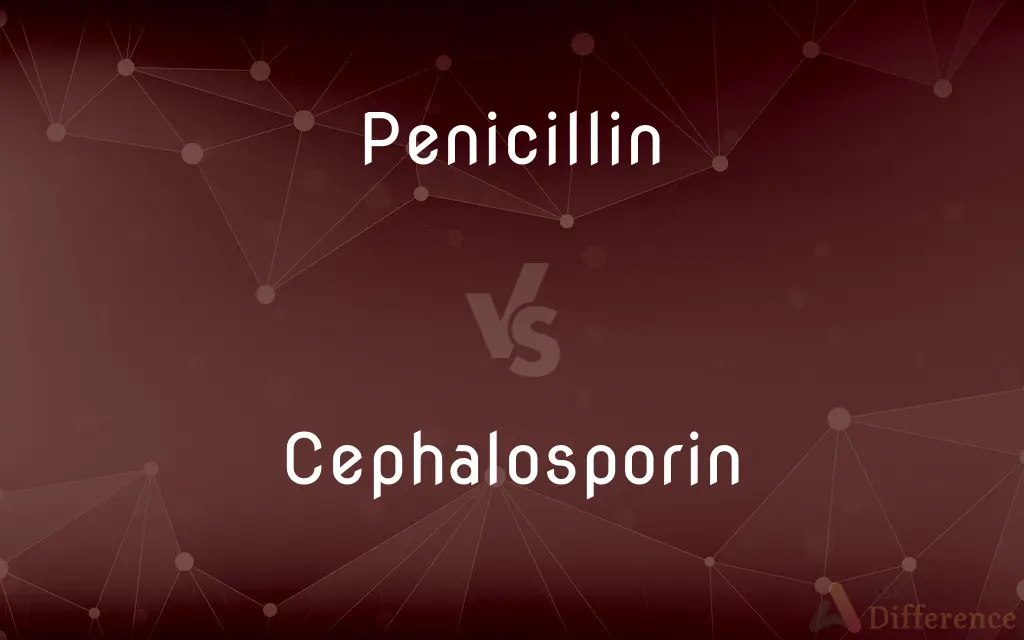Penicillin vs. Cephalosporin — What's the Difference?
By Fiza Rafique & Urooj Arif — Updated on March 25, 2024
Penicillin is a group of antibiotics derived from Penicillium fungi, effective against a wide range of bacteria, primarily targeting gram-positive organisms. Cephalosporins, derived from a fungus called Cephalosporium, are broader-spectrum antibiotics.

Difference Between Penicillin and Cephalosporin
Table of Contents
ADVERTISEMENT
Key Differences
Penicillin antibiotics were the first to be discovered and have been used since the 1940s to treat bacterial infections. They work by interfering with the synthesis of the bacterial cell wall, leading to cell death. Whereas, cephalosporins, discovered later, operate on a similar principle but have a broader spectrum of activity, including effectiveness against some gram-negative bacteria that penicillin cannot combat.
The structure of penicillin is relatively simple compared to cephalosporins, which have a more complex molecular structure that can be modified to create several generations of the drug. This modification process has allowed cephalosporins to overcome some bacterial resistance mechanisms that affect penicillin, thereby extending their range of efficacy.
Penicillin is known for its efficacy against streptococci and staphylococci, making it a first-choice treatment for infections like strep throat and certain types of pneumonia. On the other hand, cephalosporins are used in a wider range of infections, including those caused by more resistant bacteria like certain strains of E. coli and Klebsiella, especially in their later generations.
Allergic reactions are a significant concern with penicillin, with a notable percentage of the population allergic to it. While cephalosporins can also cause allergic reactions, the incidence is generally lower, and cross-reactivity between the two classes of antibiotics, though possible, is not as common as previously believed.
Comparison Chart
Rigin
Derived from Penicillium fungi
Derived from Cephalosporium acremonium fungus
ADVERTISEMENT
Spectrum
Primarily gram-positive bacteria
Broad-spectrum, including gram-positive and gram-negative bacteria
Molecular Structure
Simpler structure
More complex, allows for generation development
Typical Uses
Strep throat, syphilis, pneumonia
Wider range, including more resistant bacterial infections
Allergic Reactions
Higher incidence
Lower incidence, less cross-reactivity with penicillin
Compare with Definitions
Penicillin
Used to treat a variety of bacterial infections, including syphilis and strep throat.
Penicillin has saved countless lives since its discovery.
Cephalosporin
Effective against both gram-positive and gram-negative bacteria.
Cephalosporins are versatile antibiotics used in serious bacterial infections.
Penicillin
Known for having a potential for allergic reactions.
Patients with a penicillin allergy are often given alternative antibiotics.
Cephalosporin
Modified structurally to overcome bacterial resistance.
The development of new cephalosporin generations addresses the challenge of antibiotic resistance.
Penicillin
Can be less effective due to bacterial resistance.
Some bacteria have developed resistance to penicillin, necessitating the use of other antibiotics.
Cephalosporin
Includes several generations with varying spectra of activity.
Later generations of cephalosporins can treat a wider range of bacterial infections.
Penicillin
Effective against gram-positive bacteria by disrupting cell wall synthesis.
Penicillin was a breakthrough in the treatment of bacterial infections.
Cephalosporin
Generally causes fewer allergic reactions than penicillin.
Cephalosporin is sometimes preferred for patients with mild penicillin allergies.
Penicillin
A class of antibiotic drugs derived from Penicillium fungi.
Penicillin is often prescribed for treating bacterial throat infections.
Cephalosporin
A broad-spectrum antibiotic derived from the fungus Cephalosporium.
Cephalosporins are used when penicillin is not an option due to resistance or allergies.
Penicillin
Penicillins (P, PCN or PEN) are a group of antibiotics originally obtained from Penicillium moulds, principally P. chrysogenum and P. rubens. Most penicillins in clinical use are chemically synthesised from naturally-produced penicillins.
Cephalosporin
The cephalosporins (sg. ) are a class of β-lactam antibiotics originally derived from the fungus Acremonium, which was previously known as "Cephalosporium".Together with cephamycins, they constitute a subgroup of β-lactam antibiotics called cephems.
Penicillin
An antibiotic drug obtained from molds especially of the genus Penicillium or produced synthetically, available in various preparations and usually used to treat infections caused by gram-positive bacteria.
Cephalosporin
Any of various beta-lactam antibiotics, derived from the fungus Acremonium chrysogenum or made semisynthetically, used to treat a wide range of bacterial infections.
Penicillin
Any of a group of broad-spectrum antibiotic drugs, synthetic or semisynthetic, that are derived from penicillin.
Cephalosporin
Any of a class of natural and synthetic antibiotics developed from Acremonium fungi, having a cepham structure.
Penicillin
(pharmaceutical drug) Any of a group of narrow-spectrum antibiotics obtained from Penicillium molds or synthesized, that have a beta-lactam structure and are active against gram-positive bacteria and used in the treatment of various infections and diseases.
Cephalosporin
Any of a class of chemical substances, some of which have therapeutically useful antibacterial activity, whose structure contains a beta-lactam ring fused to a six-membered ring containing a sulfur and a nitrogen atom. The first of the series, cephalosporin C, was discovered by G. Brotzu in 1955 in the culture broth of a Cephalosporium species found off the coast of Sardinia. Other cephalosporins have been found to be produced by species of soil bacteria (actinomycetes). Many semisynthetic analogs have been tested for antibacterial effect, and several of them have found use as important clinically useful antibacterial agents, some of which may be taken orally for treatment of bacterial infections. The cephalosporins are the second class of beta-lactam antibiotic to be discovered, the first being the penicillins and more recent classes being the thienamycins and sulfazecins. The cephamycins are a variant of cephalosporins with a methoxyl group on the beta-lactam ring, rendering them more resistant to penicillinases. Among the cephalosporins which have been found clinically useful are cephalexin, cephaloridine, and cephalothin.
Penicillin
(mycology) A blue mold of the genus Penicillium that produces penicillin.
Cephalosporin
One of several broad spectrum antibiotic substances obtained from fungi and related to penicillin (trade names Mefoxin); addition of side chains has produced semisynthetic antibiotics with greater antibacterial activity
Penicillin
Any of a variety of substances having a structure containing a beta-lactam ring fused to a thiirane ring, to which a carboxyl group is attached, but most commonly interpreted as benzyl penicillin. They are notable as powerful antibacterial agents of relatively low toxicity which have found extensive use in medicine for treating bacterial infections. They are categorized as one of the classes of beta-lactam antibiotic. They are produced naturally by some fungi and bacteria, and industrial production processes almost invariably start from some form of the penicillin nucleus produced by fermentation of microorganisms. The fermentation products are then chemically modified to produce derivatives of enhanced potency, safety, or antibacterial spectrum. The first penicillin to see extensive use clinically (during World War II) was penicillin G, also called benzypenicillin, and commonly simply "penicillin".
Penicillin
Any of various antibiotics obtained from penicillium molds (or produced synthetically) and used in the treatment of various infections and diseases
Common Curiosities
Can people allergic to penicillin take cephalosporins?
People with a penicillin allergy may sometimes take cephalosporins, but it depends on the severity of their allergy. Medical advice is essential due to potential cross-reactivity.
What are the generations of cephalosporins?
Cephalosporins are divided into several generations, each with a broader spectrum of activity than the last, particularly against gram-negative bacteria, with later generations also being more effective against resistant strains.
How do penicillin and cephalosporin work?
Both penicillin and cephalosporin antibiotics work by disrupting the synthesis of the bacterial cell wall, leading to bacterial cell death.
What is bacterial resistance?
Bacterial resistance occurs when bacteria evolve mechanisms to survive exposure to antibiotics that would normally kill them or inhibit their growth, making certain antibiotics less effective.
What are penicillins and cephalosporins?
Penicillins and cephalosporins are classes of antibiotics used to treat bacterial infections, with penicillins being effective primarily against gram-positive bacteria and cephalosporins covering a broader range, including gram-negative bacteria.
What is the main difference between penicillin and cephalosporin?
The main difference is their spectrum of activity; penicillin is more effective against gram-positive bacteria, while cephalosporin has a broader spectrum, effective against both gram-positive and gram-negative bacteria.
Are penicillin and cephalosporin safe for everyone?
While both antibiotics are generally safe, they can cause allergic reactions in some individuals. It’s important to inform healthcare providers about any known allergies.
How can bacterial resistance be prevented?
Bacterial resistance can be prevented by using antibiotics responsibly, only when necessary, and completing the prescribed course, even if symptoms improve before the medication is finished.
What infections are cephalosporins commonly used for?
Cephalosporins are used for a wide range of infections, including more serious or resistant bacterial infections like certain urinary tract infections and pneumonia.
Can cephalosporins treat infections penicillin cannot?
Yes, cephalosporins can treat certain infections that penicillin cannot, especially due to their activity against gram-negative bacteria and resistant strains.
Why might a doctor choose cephalosporin over penicillin?
A doctor might choose cephalosporin over penicillin for its broader spectrum of activity, particularly if the infection is caused by bacteria that are resistant to penicillin or if the patient has a penicillin allergy.
Are cephalosporins more expensive than penicillin?
Cephalosporins can be more expensive than penicillin, especially the later generations, due to their broader spectrum of activity and the technology involved in their development.
What are common infections treated with penicillin?
Common infections treated with penicillin include strep throat, syphilis, and certain types of pneumonia.
Share Your Discovery

Previous Comparison
Ethnology vs. Anthropology
Next Comparison
Homemade vs. HousemadeAuthor Spotlight
Written by
Fiza RafiqueFiza Rafique is a skilled content writer at AskDifference.com, where she meticulously refines and enhances written pieces. Drawing from her vast editorial expertise, Fiza ensures clarity, accuracy, and precision in every article. Passionate about language, she continually seeks to elevate the quality of content for readers worldwide.
Co-written by
Urooj ArifUrooj is a skilled content writer at Ask Difference, known for her exceptional ability to simplify complex topics into engaging and informative content. With a passion for research and a flair for clear, concise writing, she consistently delivers articles that resonate with our diverse audience.
















































